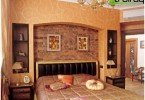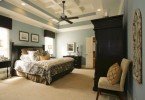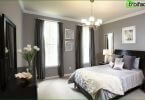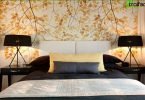The combination of wallpaper in the interior
Even standard apartments in recent years are more and more different from each other. And this happens not only due to the variety of finishing materials, but also through the efforts of talented designers who often decide on unconventional combinations in the style of interior design and in the selection of furniture and accessories. The easiest way to make your home unusual and original is to combine colors and textures in the decoration of the walls. The main thing here is to choose the right combination of wallpaper. For a person who does not have such experience, this can be difficult. This article sets out the basic rules for selecting wallpapers, furniture and textiles for rooms designed in different styles..
Content
- Basic rules for color combinations
- What is a color wheel?
- How to use the color wheel
- Wallpaper Combination Tasks
Basic rules for color combinations
What is a color wheel?
Let’s start with a look at the basic rules for combining colors. It is very convenient to select colors according to the so-called “color wheel”. It is arranged as follows:
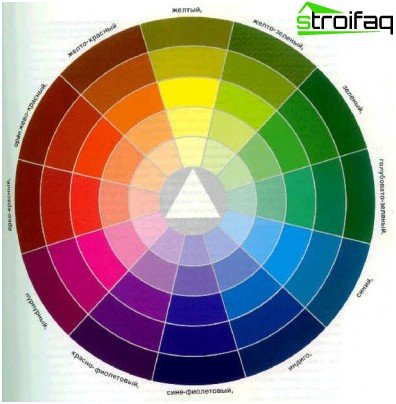
“Wheel of color” will help to correctly select colorful combinations
It is generally accepted that there are only 3 primary colors – red, blue and yellow.
If these colors are mixed in pairs, we get three secondary colors – purple, green and orange.
Continuing mixing, we get a palette of 12 colors.
How to use the color wheel
To create a soft, calm interior, it is recommended to combine the neighboring colors of the spectrum. Such a solution is more suitable for a bedroom or a relaxation room, in a word for rooms designed for relaxation and pacification.
For an active and bright interior, the opposite colors of the wheel are preferable. Their combination is justified in the living room, children’s room or office.
Wallpaper Combination Tasks
Let’s look at cases where the combination of different colors and shades of wallpaper has not only aesthetic value, but also helps to correct the flaws in the geometry of the room:
- A small room with high ceilings is always like a box; the correct combination of wallpapers will help to fix this..
- There is a need to divide a large room into functional areas.
- The right combination of colors and textures will help visually expand a room that is too long.
- If the room has a large wall, not occupied by furniture, a combination of wallpapers will help to give it dynamics.
- There is a need to put emphasis on one of the walls.
Some combination techniques
Let’s look at some of the most common wallpaper combining techniques and the results that can be achieved by applying them..
Horizontal division of the wall
The most common way of combining wallpaper in recent years.
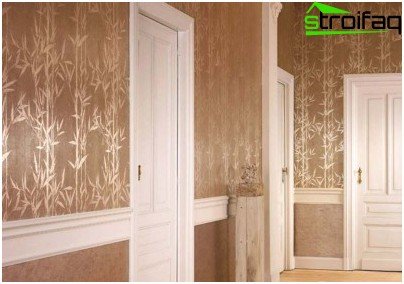
The horizontal division of the walls in the hallway – a design technique that creates the illusion of expanding space
Most often, the wall is divided into 3 parts, the top two are pasted over with wallpaper of the same color, and the bottom – of the other. There are several classic tricks of this combination:
- Bottom – stripe, top – plain wallpaper or small pattern
- Bottom – plain wallpaper, top – large drawing
- Bottom – large floral ornament, top – plain wallpaper.
It is desirable that the wallpaper was from the same series, or at least combined in color. You can decorate the horizontal joint between the wallpaper with either a decorative strip or polyurethane molding. This method is most justified in rooms with high ceilings, where you need to visually crush a large section of the wall.
Vertical Stripes
This technique is ideal for owners of apartments in Soviet-built houses, as a rule, one of the rooms here is more like a wide corridor or pencil case. To make it more square, at least visually, a combination of bright wallpapers with a large pattern with calm plain wallpapers will help. You can glue them in three ways:
Bright broad stripes are glued in the center of the room’s long walls – one opposite the other. The effect is that a person visually perceives precisely these bright spots and the room is visually “shortened”.
In order to make the room look not just shorter, but use the principle of “asymmetry” a bit wider. At the same time, one of the long walls is glued with a wide bright strip in the center, and on the other several narrow stripes in the far corner of the room. It is desirable that these stripes be of different widths.
Another effective way to “expand” a narrow room is the alternation of stripes. In this case, one of the long walls is completely covered with dark wallpaper, and one of the short ones is light. The second short wall is glued with alternating strips of dark and light wallpaper, with a small approach to the second long wall. This alternation allows you to blur the clear outline of the room.
Important! Using this combination of wallpaper in the living room, bedroom or office, remember that the wallpaper should be from the same material. Otherwise, the joints between the sheets will not look neat.
Highlight a wall section with texture or color
In a room with complex architecture, sometimes it is necessary to highlight some structural element. This is especially true if the main wallpaper in the room is colorful enough. Such a picture somewhat “lubricates” the design features of the room. It is enough to paste over a niche or column with tapestries of a different texture or a calmer shade, as they immediately become more noticeable.
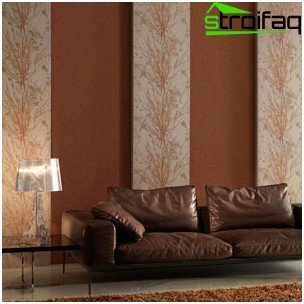
Highlighting a niche with other wallpapers focuses on significant pieces of furniture and interesting architectural elements.
This combination of wallpaper is also applicable if you want to draw attention to one of the interior items. To do this, just select the wall around it with other wallpapers.
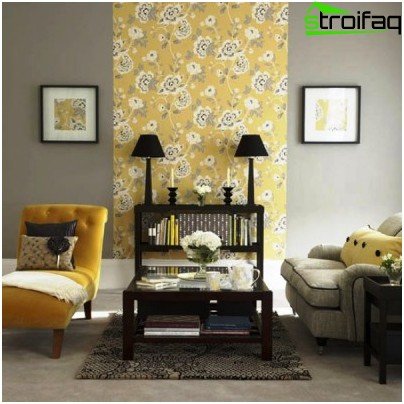
Highlighting home decor using a combination of wallpapers
When it is necessary to clearly zone the room, the easiest way to do this is with different wall finishes. In this case, you can apply not only color variations, but also different types of wallpaper.
Select a whole wall
This method is rarely used. The fact is that highlighting the whole wall with contrasting wallpaper visually makes the room smaller.
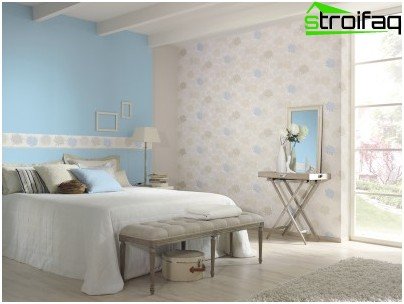
You can highlight the whole wall with color, texture of wallpaper, pattern
Most often, this combination of wallpaper is used in a large bedroom, when the selected furniture is somewhat lost in a spacious room.
The visual compartment of the other room
If you decide to get rid of bulky doorways and connect rooms, this method is for you. In order to visually separate one room from another, it is enough to paste over them with wallpapers of different colors.
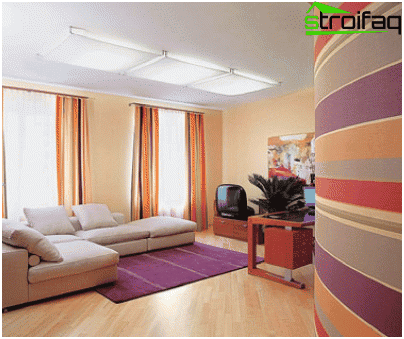
The combination of wallpaper in one of the adjacent rooms with curtains in the other
The effect will be greatly damaged if the walls in two different rooms are very different from each other. A combination of wallpaper and curtains will help to fix this. For example, if the pattern and shade of the curtains in one adjacent room are in harmony with the wallpaper in another.
“Panel” from the wallpaper
Another fairly common way of decorating walls in a large room is the formation of decorative inserts from bright trellises.
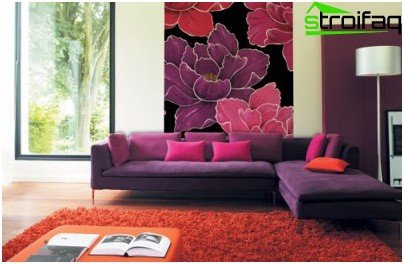
A “panel” of wallpaper creates the mood the owner wants in a room
Surely, browsing the catalogs of expensive wallpapers, you have repeatedly admired the richness of color and grace of ornament. So maybe it’s worth buying just one roll and using it as a kind of art object.
Turn it on, but control the fantasy
All the combination methods described above can be combined with each other. The main condition for success in creating an interior is a sense of proportion. In the pursuit of originality, it is easy to “go too far” and make your home look like a Harlequin costume.
If you really liked the combination of wallpaper, the photo of which you saw in the magazine, but the size of the room does not allow you to apply just such a design, try sticking the same wallpaper in a different way. Perhaps what you get will be no worse than the creation of a famous designer.
Wall mural – a new word in design
Unfortunately, the word “mural” in the minds of many is associated with something long gone out of fashion. And completely in vain. Just look at the catalogs of the manufacturers of this miracle and you will certainly want to use it in your home.
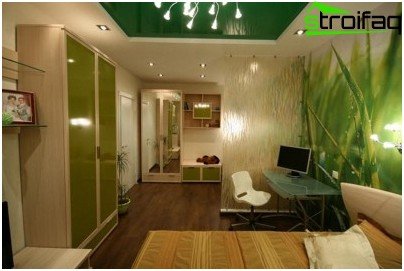
Matching the color of the walls to the photo wallpaper
Wall murals are probably the easiest way to diversify the interior. But they require compliance with some rules:
- Do not overload the room – wall murals do not tolerate combinations with a large pattern on other trellises.
- Be sure to choose the decoration of the room to match the photo wallpaper or build the interior in contrast – use the opposite colors in the “color wheel”.
- Landscape murals cannot be bent, that is, transferred from one wall to another through an angle.
- In a small room, it is recommended that you use a full-wall photo wallpaper..
- Wall mural should clearly fit into the style of the interior. In a hi-tech style room, even the most beautiful pink flowers will be inappropriate.
- The only style that does not tolerate the use of photo wallpaper is classic.
Putting into practice all our tips, you can create a truly unique interior. Go ahead, perhaps in a few years it will be your work that will show off on the front pages of fashion magazines.


